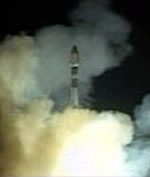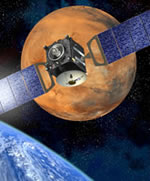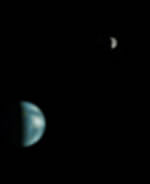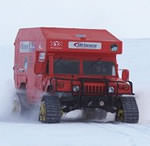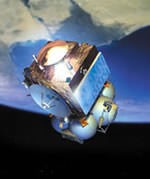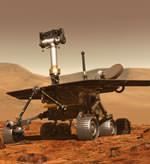
Image credit: NASA
The invasion of Mars continues. Next up: NASA’s Mars Explorer Rover-A which has been cleared to launch Sunday, June 8 at 1805 GMT (2:05pm EDT). Rover-A and its twin carry a suite of geological instruments to examine rocks and soil searching for evidence of past water on Mars. Scientists back on Earth will guide the rovers to various target rocks for closer examination. The second rover is due to launch June 25 and will aim towards a different landing site on the Red Planet.
NASA’s Mars Exploration Rover project kicks off by launching the first of two unique robotic geologists on June 8. The identical rolling rovers can see sharper images, explore farther and examine rocks better than anything that’s ever landed on Mars. The second rover mission, bound for a different site on Mars, will launch as soon as June 25.
“The instrumentation onboard these rovers, combined with their great mobility, will offer a totally new view of Mars, including a microscopic view inside rocks for the first time,” said Dr. Ed Weiler, associate administrator for space science at NASA Headquarters, Washington, D.C. However, missions to Mars have proven to be far more hazardous than missions to other planets. Historically, two out of three missions, from all countries that have tried to land on Mars, ended in failure. We have done everything we can to ensure our rovers have the best chance of success.”
The first Mars Exploration Rover will arrive at Mars on Jan. 4, 2004; the second on Jan. 25. Plans call for each to operate for at least three months.
These missions continue NASA’s quest to understand the role of water on Mars. “We will be using the rovers to find rocks and soils that could hold clues about wet environments of Mars’ past,” said Dr. Cathy Weitz, Mars Exploration Rover program scientist at NASA Headquarters. “We’ll analyze the clues to assess whether those environments may have been conducive to life.”
First, the rovers have to safely reach Mars. “The rovers will use innovations to aid in a safe landing, but risks remain,” said Peter Theisinger, Mars Exploration Rover project manager at NASA’s Jet Propulsion Laboratory, Pasadena, Calif.
The rovers will bounce to airbag-cushioned landings at sites offering a balance of favorable conditions for safe landings and interesting science. The designated site for the first mission is Gusev Crater. The second rover will go to a site called Meridiani Planum. “Gusev and Meridiani give us two different types of evidence about liquid water in Mars’ history,” said Dr. Joy Crisp, Mars Exploration Rover project scientist at JPL. “Gusev appears to have been a crater lake. The channel of an ancient riverbed indicates water flowed right into it. Meridiani has a large deposit of gray hematite, a mineral that usually forms in a wet environment.”
The rovers, working as robotic field geologists, will examine the sites for clues about what happened there. “The clues are in the rocks, but you can’t go to every rock, so you split the job into two pieces,” said Dr. Steve Squyres of Cornell University, Ithaca, N.Y., principal investigator for the package of science instruments on the rovers.
First, a panoramic camera at human-eye height, and a miniature thermal emission spectrometer with infrared vision help scientists identify the most interesting rocks. The rovers can watch for hazards and maneuver around them. Each six-wheeled robot has a deck of solar panels, about the size of a kitchen table, for power. The rover drives to the selected rock and extends an arm with tools on the end. Then, a microscopic imager, like a geologist’s hand lens, gives a close-up view of the rock’s texture. Two spectrometers identify the composition of the rock. The fourth tool substitutes for a geologist’s hammer. It exposes the fresh interior of a rock by scraping away the weathered surface layer.
Both rover missions will lift off from Cape Canaveral Air Force Station, Fla., on Delta II launch vehicles. Launch opportunities begin for the first mission at 2:06 p.m. (Eastern Daylight Time) June 8 and for the second mission at 12:38 a.m. June 25, and repeat twice daily for up to 21 days for each mission.
“We see the twin rovers as stepping stones for the rest of the decade and to a future decade of Mars exploration that will ultimately provide the knowledge necessary for human exploration,” said Orlando Figueroa, director of the Mars Exploration Program at NASA Headquarters.
Original Source: NASA News Release

